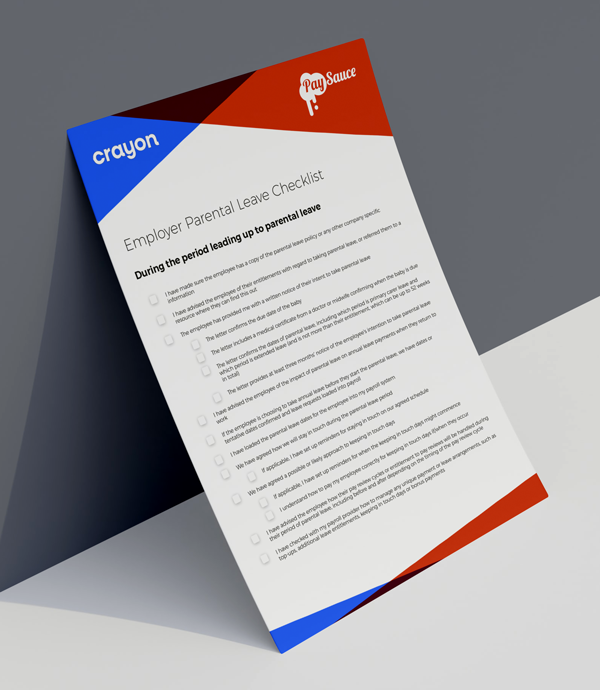Parental Leave
Employee Entitlements to Parental Leave
This is a guest collaboration series with our friend Stephanie Pow from Crayon - she's building the first home for money and parenthood in New Zealand, helping parents navigate the unique financial puzzles they face so they can be the parents they want to be.
This part of the series covers what your employees are entitled to, so you know your obligations as an employer.
In New Zealand, parental leave entitlements are governed by the Parental Leave and Employment Protection Act 1987.
An employee has to meet eligibility requirements to be entitled to take parental leave from their employer (i.e. to take the time away from work) and to receive parental leave payments from the government. It can be the case that an employee is entitled to 26 weeks of parental leave payments but not to the time off to actually receive the payments!
The legislation applies to people who are:
Giving birth to a child, or the partner of someone who is giving birth
Taking permanent responsibility for a child under the age of six (e.g., adoption)
The legislation stipulates different entitlements for:
Primary carer: by default, the person who is pregnant is considered the Primary Carer; if a couple is taking permanent responsibility, then they need to nominate one person to be the Primary Carer
Partner (sometimes referred to as secondary carer)
As far as the legislation is concerned, there can only be one Primary Carer at any given time during parental leave. The Primary Carer can transfer some or all of their parental leave entitlements to their Partner if both meet the eligibility requirements. A little fact: fewer than 1% of men have historically become the Primary Carer.
To be eligible for parental leave, an employee must:
Work for a New Zealand employer;
Pay tax in New Zealand; and
Have employment that is subject to New Zealand law.
From there, the eligibility criteria depends on the employee’s work history. Note that all timeframes discussed in the section below work backwards from the date the employee expects to welcome the child.
Primary Carer
An employee who has worked for the same employer for 12 months or more for at least an average of 10 hours a week is entitled to:
10 days of unpaid special leave for pregnancy-related reasons such as morning sickness, antenatal classes, scans or medical appointments.
52 weeks of extended parental leave, including 26 weeks of primary carer leave
26 weeks of parental leave payments from the government
The payment is designed to replace the employee’s weekly income up to a cap of $712.17 a week before tax (as at 1 July 2023)
An employee who has worked for the same employer for at least 6 months but less than 12 months for at least an average of 10 hours a week is entitled to:
10 days of unpaid special leave for pregnancy-related reasons
26 weeks of primary carer leave
26 weeks of parental leave payments from the government
An employee can take parental leave for each child they have, but they need to have been back at work for 6 months to be eligible for 6 months of parental leave for each child (and 12 months for 12 months of parental leave) - even if they’ve worked for the same employer for years.
If an employee has worked for less than 6 months at the same employer or for less than an average of 10 hours a week (regardless of how long they’ve worked for that employer), or they’ve been back at work for less than 6 months since their last parental leave, then they would have to apply for negotiated carer leave because they are not entitled to any time off from their current employer. Here’s where it gets interesting: they may still be entitled to parental leave payments if they have worked as an employee for an average of at least 10 hours a week for any 26 of the 52 weeks before their child arrives (this includes combining hours worked for more than one employer, even if there were periods when they did not work).
Employees are also entitled to have additional payments and extend their leave in the event their baby arrives early. If the baby arrives earlier than 37 weeks, the employee can apply for pre-term baby payments to take them through to the end what would have been week 36.
Partner
An employee who has worked for the same employer for 12 months or more for at least an average of 10 hours a week is entitled to:
2 weeks of unpaid partner leave
Share the primary carer leave and extended leave with the Primary Carer up to a total of 52 weeks
An employee who has worked for the same employer for at least 6 months but less than 12 months for at least an average of 10 hours a week is entitled to:
1 week of unpaid partner leave
Share the primary carer leave and extended leave with the Primary Carer up to a total of 26 weeks
If an employee has worked for less than 6 months at the same employer or for less than an average of 10 hours a week (regardless of how long they’ve worked there), then they are not entitled to any leave.
However, if they have worked as an employee for an average of at least 10 hours a week for any 26 of the 52 weeks before their child arrives (reminder: this can be across more than one employer), they are eligible to receive up to 26 weeks of parental leave payments if the Primary Carer chooses to transfer the entitlement to them and they successfully apply for negotiated carer leave.
Working out who gets what
Employment New Zealand has created this table to help people work out who is entitled to what. If you prefer to get a specific answer for an employee, you can use the Crayon Parental Leave Navigator. And if your head is spinning, you’re not alone (74 pieces of logic sit behind the tool!).
Requesting parental leave
Employees need to inform you in writing about their intention to take parental leave at least 3 months before their due date if birthing or 14 days if taking permanent responsibility of a child under the age of six. As an employer, you have 42 days to respond:
7 days to ask your employee for more information
14 days for your employee to get the information
21 days to provide your formal response as an employer, which includes confirming if they’re eligible for parental leave and whether they’re able to return to the same position that they’re currently working in
Employment NZ provides templates here for employees and employers.
Employees need to apply for paid parental leave via the IRD. The earliest the employee can apply is when they have the paperwork showing that they’re expecting a child (e.g., letter from midwife/OB, court order). This must be done before they return to work from parental leave and before their child turns one (if birthing) or the 12 month anniversary of the child coming into their care (if taking permanent responsibility of a child under the age of six e.g., adoption).
Keeping in touch hours
In New Zealand, employees can work “Keeping In Touch” (KIT) hours while they’re receiving the government paid parental leave. The rules governing KIT hours:
Both the employee and employer must agree to any KIT hours worked - either party can refuse
The employee may work full days or part days, a few hours at a time or do all 64 hours in a consecutive period. They are paid their normal working wage for time worked.
The maximum keeping in touch hours an employee can use is 64 hours over the 26-week paid parental leave period.
If they work over 64 hours, the IRD will consider them to returned to work. They would no longer be eligible for further parental leave payments and may have to pay back any overpayments.
Keeping in touch hours cannot be used within the first 28 days after their child arrives.
If you want to give your employee this option, then you should agree on how those hours can be used, ideally before they go on parental leave.
 Stephanie Pow
Founder & CEO - Crayon
Stephanie Pow
Founder & CEO - Crayon
 Jessica McLean
CPO - PaySauce
Jessica McLean
CPO - PaySauce


